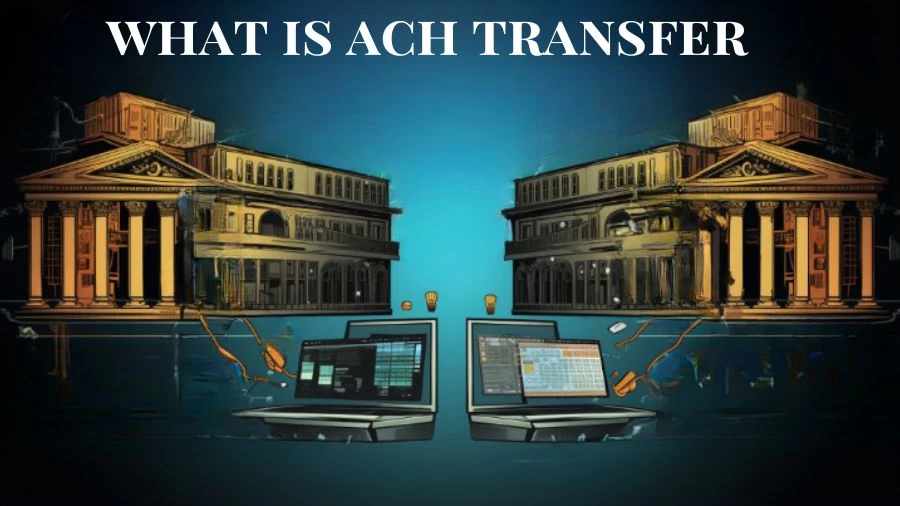
What is ACH Transfer? What Are the Types of ACH Transfers?
An ACH transfer is an electronic method for securely moving funds between banks, individuals, and businesses, replacing paper checks and offering streamlined financial transactions.
by Kowsalya
Published Aug 29, 2023 | Updated Aug 29, 2023 | 📖 2 min read
What is ACH Transfer?
ACH transfers encompass electronic, interbank money transfers processed through the Automated Clearing House (ACH) Network. This network, managed by Nacha, operates as a batch processing system, allowing financial institutions to aggregate transactions for streamlined processing.Direct deposits pertain to inflows into accounts, such as salary, benefits, and tax refunds, while direct payments encompass outflows, including bill settlements or peer-to-peer transfers.
Notable for their convenience, speed, and often zero-cost nature, ACH transfers might come with transaction limits, supplementary charges, and potential delays. Frequently, individuals employ ACH transfers unwittingly, like receiving wages via direct deposit or settling bills online via their bank accounts.
ACH transfers extend to making one-time or recurrent deposits into various accounts like IRAs, taxable brokerage accounts, and educational savings accounts. Furthermore, businesses utilize ACH for vendor disbursements and client receipts.
The popularity of automated system payments is on the rise. Nacha's data reveals 29 billion payments in 2021, an 8.7% surge from the preceding year. Notably, person-to-person transactions rose by 24.9% to 271 million, while business-to-business transactions escalated by 21% to 5.3 billion. ACH transfers boast diverse applications, often proving more cost-effective and user-friendly compared to checks or card payments. For those curious about ACH transfers, here's a comprehensive guide to their mechanics.
How Long Does an ACH Transfer Take?
The duration of ACH transfers varies from a few hours to a maximum of three business days, contingent upon the payment initiation time and the inclusion of same-day processing. ACH withdrawals, like bill payments or deductions, typically necessitate 1 to 3 days for processing. Conversely, ACH deposits, such as direct deposits or vendor disbursements, usually require just one day for processing.
For expedited ACH transfers on the same day, usually subject to an additional fee, the processing occurs within the same business day. Concerning standard ACH payments, the originating depository financial institutions (ODFIs) generally settle by 8:30 AM on the subsequent business day for debit requests, and by 8:30 AM on the second business day for credits.
ACH Transfer Fees
Engaging with ACH through an intermediary Third-Party Payment Processor (TPPP) can entail various fee categories. Here is the list of the categories:
|
Type of Fee |
Typical Cost Range |
|
Flat Fee (per transaction) |
$0.20 - $1.50 |
|
Percentage Fee (per transaction) |
0.5% - 1.5% |
|
Monthly Fee |
$5 - $30 |
|
Batch Fee (per batch) |
<$1 |
|
ACH Return Fee (per return) |
$2 - $5 |
|
ACH Reversal / Chargeback Fee |
$5 - $25 |
How to Do an ACH Transfer?
ACH (Automated Clearing House) network offers two primary methods for conducting payments: ACH Debit and ACH Credit.
ACH Debit
ACH Debit functions as a 'pull' mechanism for payment, initiated by the entity receiving the funds. In this arrangement, you provide authorization to an organization or business, permitting them to 'pull' a specified amount from your account on predetermined dates. This method is commonly employed for regular monthly expenses like utility bills, insurance premiums, and similar recurring payments. Similarly, businesses may use ACH Debit to cover routine services they receive.
ACH Credit
Conversely, ACH Credit operates as a 'push' mode of payment instigated by the account holder. This approach eliminates the necessity of sharing your account details with the recipient.
You, along with your bank, establish and execute the payment, while the recipient awaits the funds passively. ACH Credit is commonly utilized for depositing salaries into employee accounts. Furthermore, consumers often leverage this method to settle bills, make purchases, send funds to friends or family, and engage in various financial transactions.
In summary, ACH network offers two distinctive avenues for facilitating transactions. ACH Debit empowers payees to 'pull' funds from your account with your prior consent, typically catering to recurring expenses. On the other hand, ACH Credit empowers you to 'push' funds into the recipient's account, enabling various financial activities while safeguarding your account information.
ACH Online Transfer
The Automated Clearing House (ACH) stands as the principal financial network in the United States for conducting electronic money transfers and payments. This system assures swift and efficient ACH payments, presenting the opportunity to establish both single-instance and recurrent transactions. These transactions could encompass vendor or supplier payments, achieved with remarkable ease through a simple click.
Zil Money, an integrated platform, offers a comprehensive array of payment options. These encompass Automated Clearing House transfers, wire transfers, printable checks, as well as checks dispatched via mail. A distinctive aspect is the incorporation of a modest transaction fee, rendering the process cost-effective. The platform is engineered to streamline payment procedures, bringing the advantage of automation under one unified roof.
A paramount feature of Zil Money is its commitment to robust security measures. Employing safeguards akin to those utilized by the military, Zil Money ensures that all transfers occur within a secure environment, reassuring users of the safety of their financial transactions. Through this system, payers can confidently send funds while receivers can trust in the integrity of the process.
What Are the Types of ACH Transfers?
ACH transfers have revolutionized convenience for both senders and recipients, eliminating the need for traditional check writing and in-person bill payments. The era of waiting for checks to clear or rushing to make timely payments is transitioning into a more streamlined process.
While the traditional methods still stand, contemporary alternatives have emerged. ACH transfers offer a seamless and secure way to send and receive funds from the comfort of your own home. Within the ACH Network, two primary types of transactions are facilitated: ACH Direct Deposits and ACH Direct Payments.
ACH Direct Deposits: An ACH direct deposit involves electronic transfers initiated by businesses or government entities to consumers. This category encompasses an array of payments, such as:
- Paychecks
- Reimbursements from Employers
- Government Benefits
- Tax Refunds
- Annuity Payments
- Interest Payments
With ACH direct deposits, you are the recipient of funds. In contrast, when you initiate such a transfer, it's known as an ACH direct payment.
ACH Direct Payments: Direct payments cater to a diverse audience including individuals, businesses, and various organizations. For instance, settling bills online through your bank account constitutes an ACH direct payment. Popular social payment platforms like Venmo and Zelle also leverage the ACH network for peer-to-peer transfers.
In an ACH direct-payment transaction, the sender of funds observes an ACH debit in their bank account, indicating the recipient and amount paid. The recipient, on the other hand, records the incoming funds as an ACH credit. This mechanism involves the sender pulling money from their account, while the recipient's account receives the funds through a push.
What Are the Benefits of ACH Transfers?
Leveraging ACH transfers for bill payments and person-to-person transactions brings forth numerous advantages, chiefly starting with the element of convenience. Opting to settle recurring expenses like mortgages, utility bills, or other monthly dues through electronic ACH payments proves simpler and less time-consuming than the traditional route of writing and sending checks.
Furthermore, this approach eliminates the need for purchasing stamps, leading to potential cost savings. Beyond convenience, ACH payments also often enhance security compared to alternative payment methods.
The expediency of sending and receiving ACH payments is another noteworthy perk. Typically, transactions, or the transfer of funds between banks via the ACH Network, culminate on the succeeding day post-initiation. Guided by Nacha operating rules, credits are mandated to settle within one to two business days, whereas debits conclude within the subsequent business day.
In addition to their speed, ACH transfers commonly come without a financial burden and are often more user-friendly in comparison to drafting checks or utilizing credit and debit cards for bill payments. Moreover, the financial implications are minimal, if any, contingent upon your banking institution and the transfer nature. For instance, the process of moving funds from your checking account to another bank account may incur no charges. Even if fees are applicable, they are likely to be nominal, involving only a small sum.
An additional benefit lies in the cost-effectiveness of ACH transfers when juxtaposed with wire transfers, which often range from $25 to $75 for international outbound transfers. While wire transfers boast swiftness, often catering to same-day requirements, they occasionally entail longer processing times. In the case of international wire transfers, the process could span several business days for the actual funds movement, followed by additional days for the transfer's clearance.
How to Make ACH Transfers More Quickly?
Virtually all financial institutions establish cutoff times for transfer requests, and adhering to these times is crucial to ensure the punctual arrival of your funds. Should you initiate a transfer request post the established cutoff, typically toward the close of the business day, it's highly likely that the processing won't commence until the subsequent business day.
For those seeking even swifter transfer processing, there is often an option to expedite delivery speed for ACH transfers, provided your financial institution extends such a choice.
Some banks furnish the opportunity for next-day delivery, albeit often at an additional fee. However, it's essential to note that the term "next day" generally pertains to the subsequent business day rather than the following calendar day. An important change implemented in March 2018 has enabled most ACH payments, encompassing payroll and account-to-account transfers, to be executed on the same day they are requested.
Alternately, you can harness the capabilities of Zelle, a payment application that collaborates directly with a wide spectrum of banks and credit unions. Zelle ensures immediate money delivery to the recipient, with the transfer subsequently reaching finalization through conventional ACH processing or in real-time if the bank utilizes the RTP network, a system enabling real-time payments. It's noteworthy that Zelle itself doesn't impose fees; however, certain banks might apply their own charges.
If you contemplate utilizing ACH transfers as a cost-effective means of money movement, it's prudent to familiarize yourself with your bank's specific policies beforehand. This strategic approach aids in evading unexpected fees, processing delays, potential limitations, and maximizes the efficacy of the service at your disposal.
What is an ACH Bank Transfer?
An ACH bank transfer denotes an electronic financial transaction conducted between banks, primarily employed for the facilitation of payments. This transfer transpires within a framework referred to as an "automated clearing house," abbreviated as ACH. The scope of ACH bank transfers encompasses a multitude of applications, including but not limited to, direct deposit of earnings, periodic settlement of debts, and seamless money transfers.
At its core, an ACH bank transfer represents a digital exchange of funds between financial institutions. This modernized approach eliminates the need for physical checks and manual processing, streamlining the movement of money across accounts and enhancing the efficiency of financial transactions. The ACH system acts as the conduit through which these transactions flow, ensuring secure and expedient movement of funds.
These transfers cater to an array of financial needs, ranging from salary disbursements directly into employees' bank accounts, to systematically settling recurring bills without requiring manual intervention. Additionally, ACH bank transfers offer a convenient mechanism for individuals and businesses alike to transmit funds swiftly and safely to others, bolstering the accessibility and reliability of financial transactions.
What is ACH Transfer - FAQs
1. What is an ACH transfer?
ACH transfer is an electronic method of moving funds between different accounts, including bank-to-bank transfers, direct deposits, bill payments, and person-to-person transactions.
2. How does an ACH transfer work?
ACH transfers involve sending electronic instructions containing payment details from one bank to another, enabling secure and automated money movement.
3. What are the typical uses of ACH transfers?
ACH transfers have a wide range of applications, including direct deposits of salaries, settling recurring bills, making person-to-person payments, and facilitating business-to-business transactions.
4. How long do ACH transfers take to process?
ACH transfer times vary, usually taking a few hours to three business days for standard transactions.
5. Are ACH transfers secure?
Yes, ACH transfers are generally secure.




